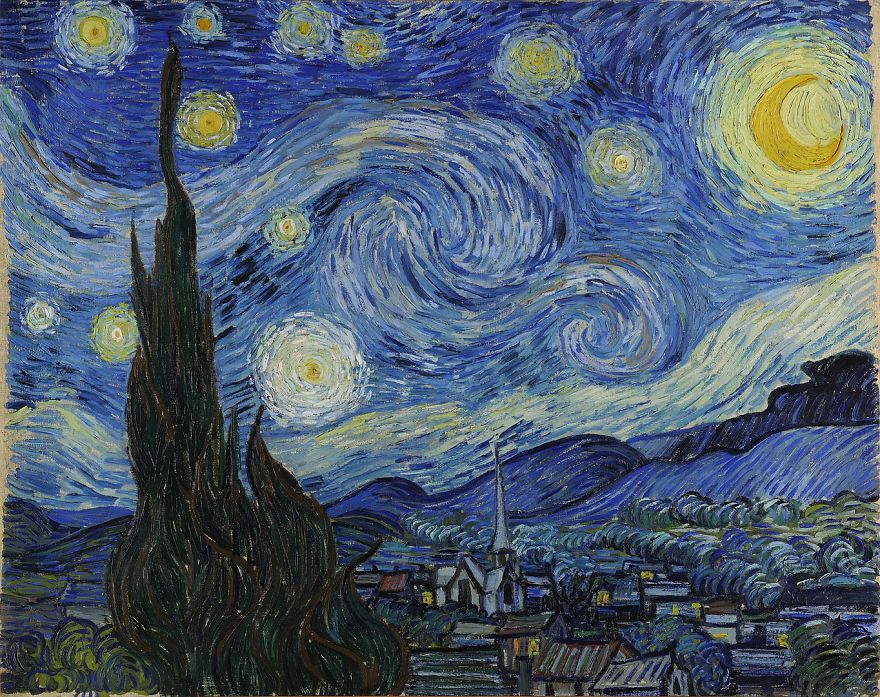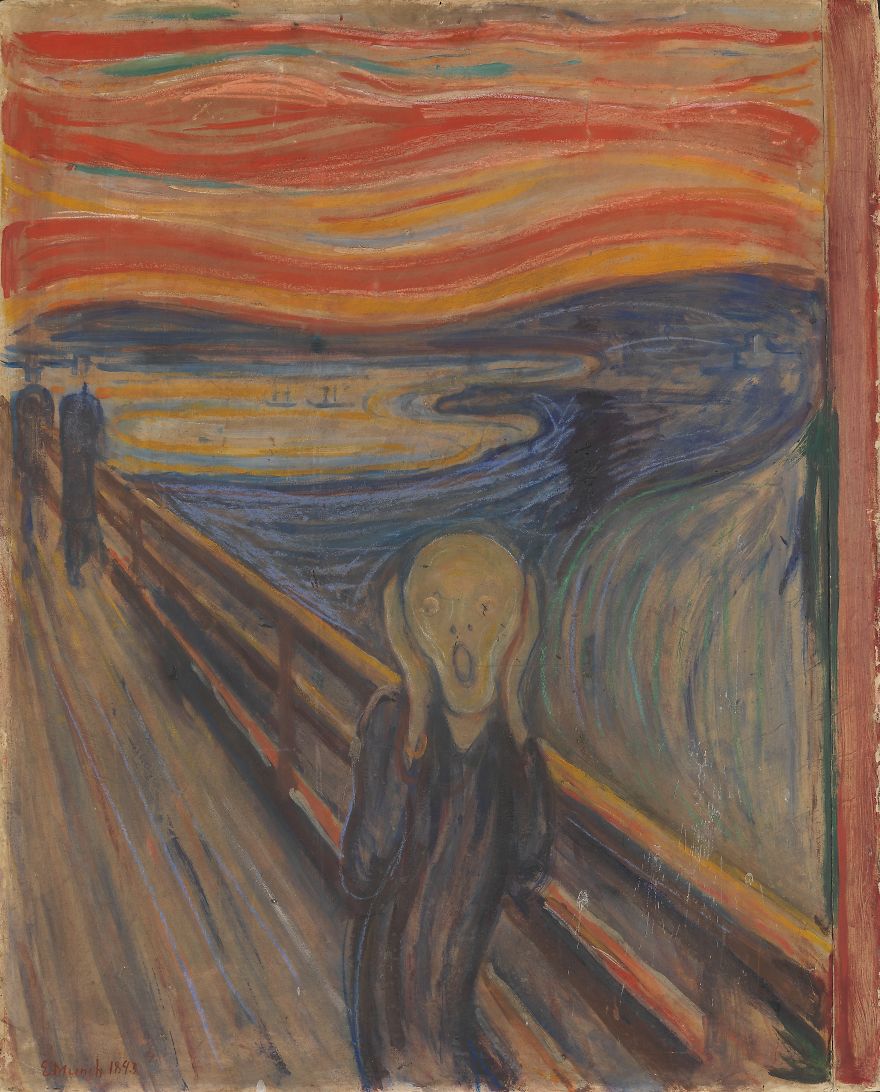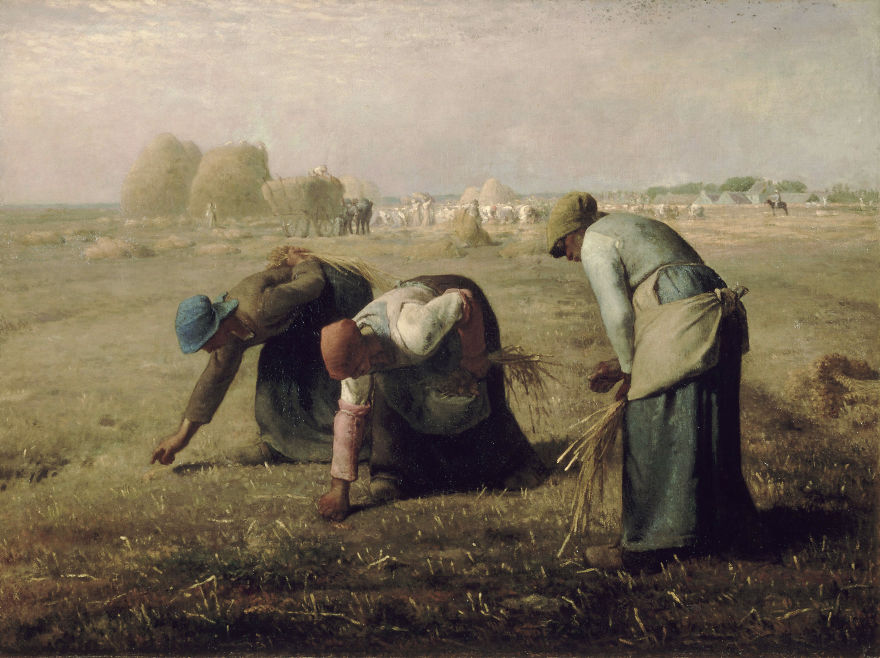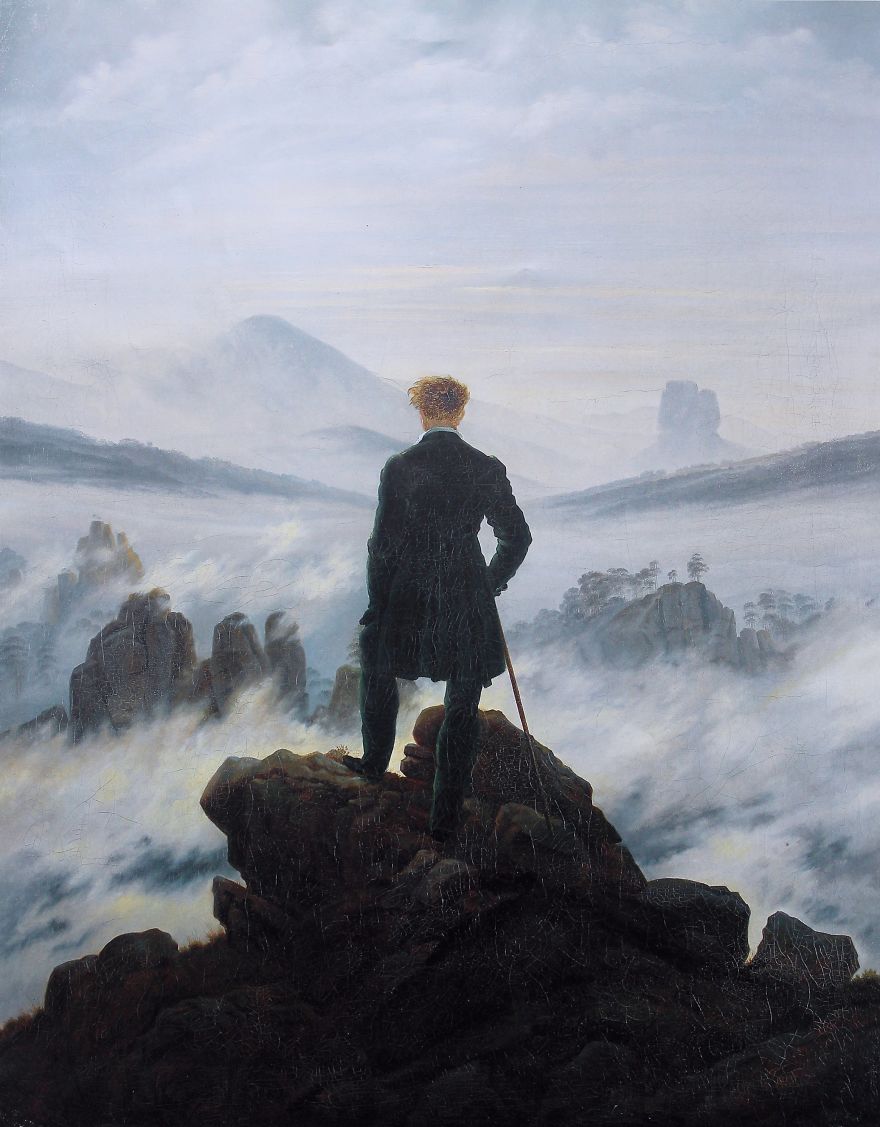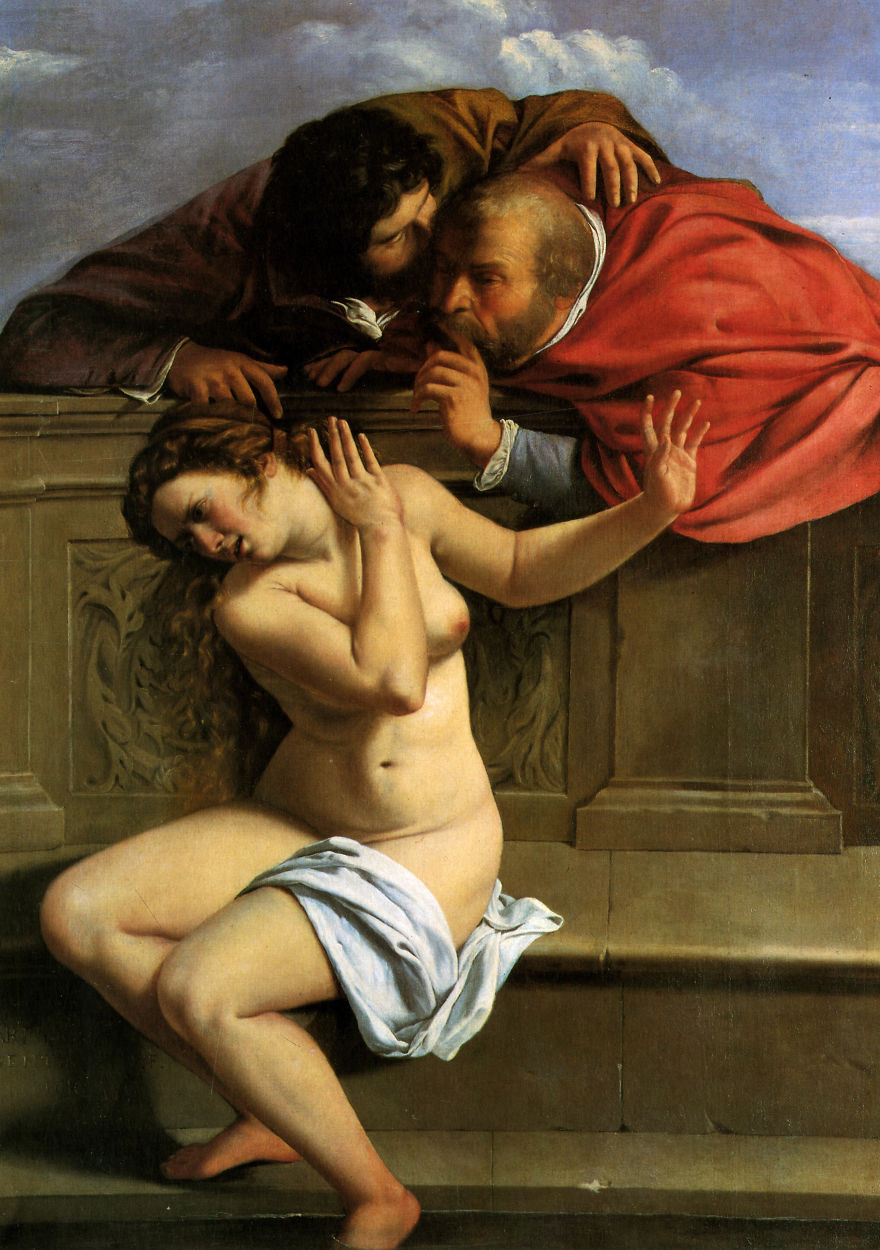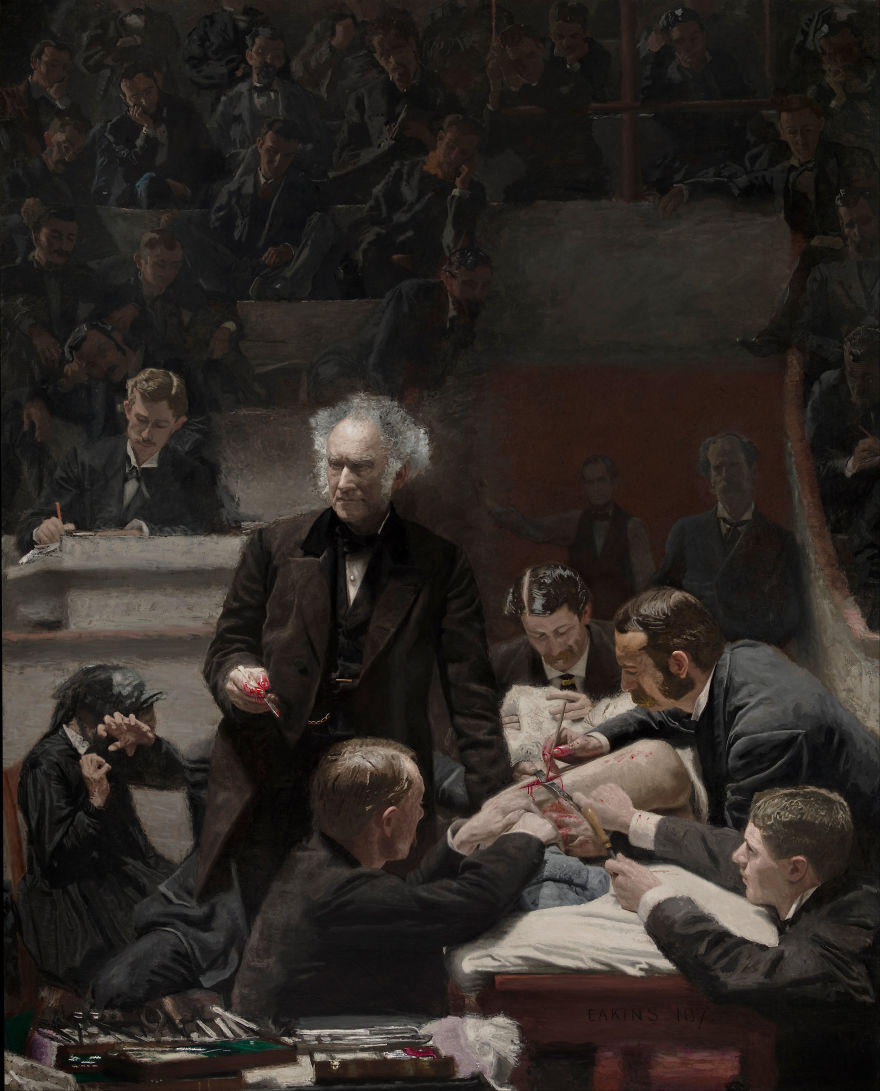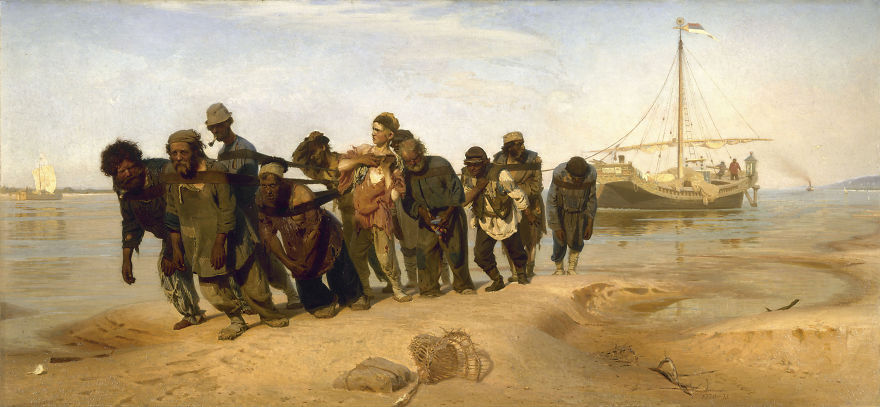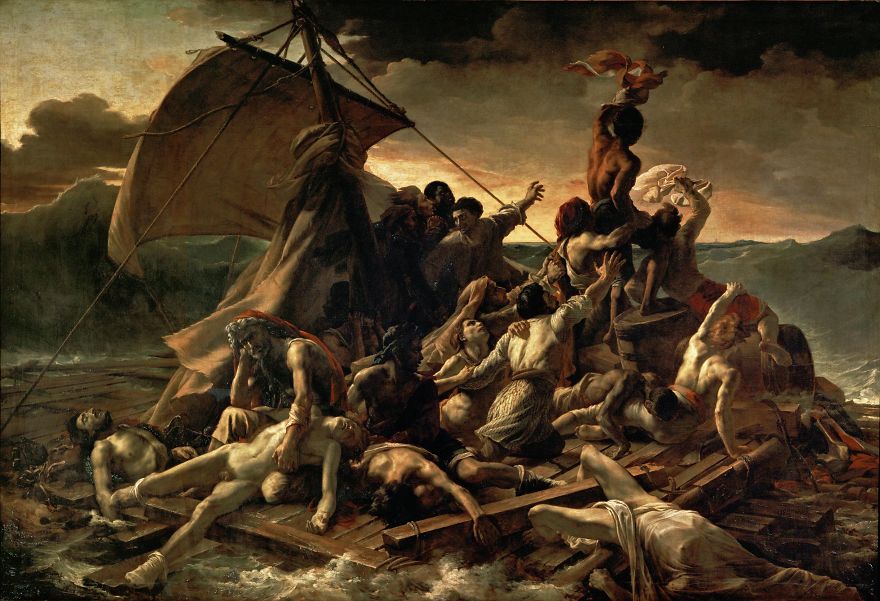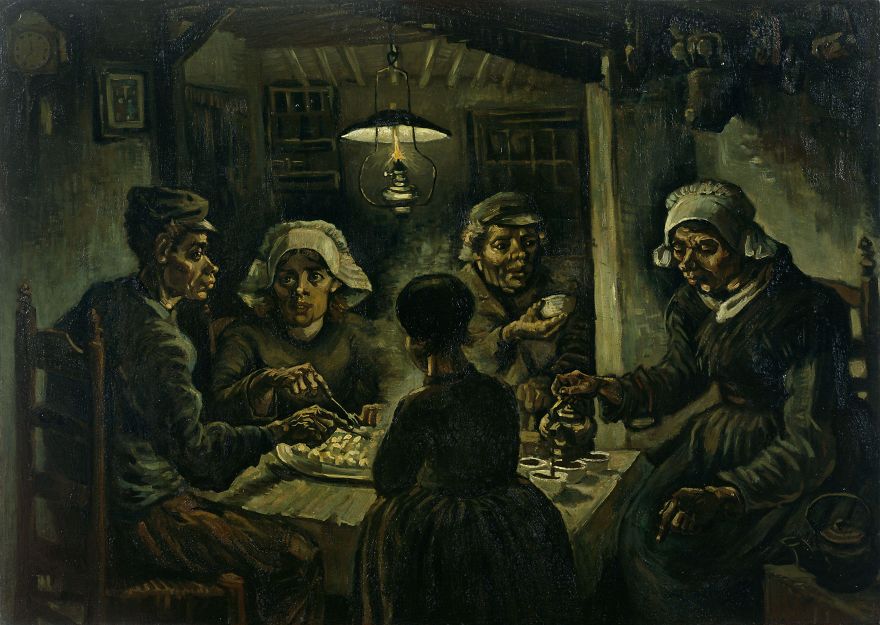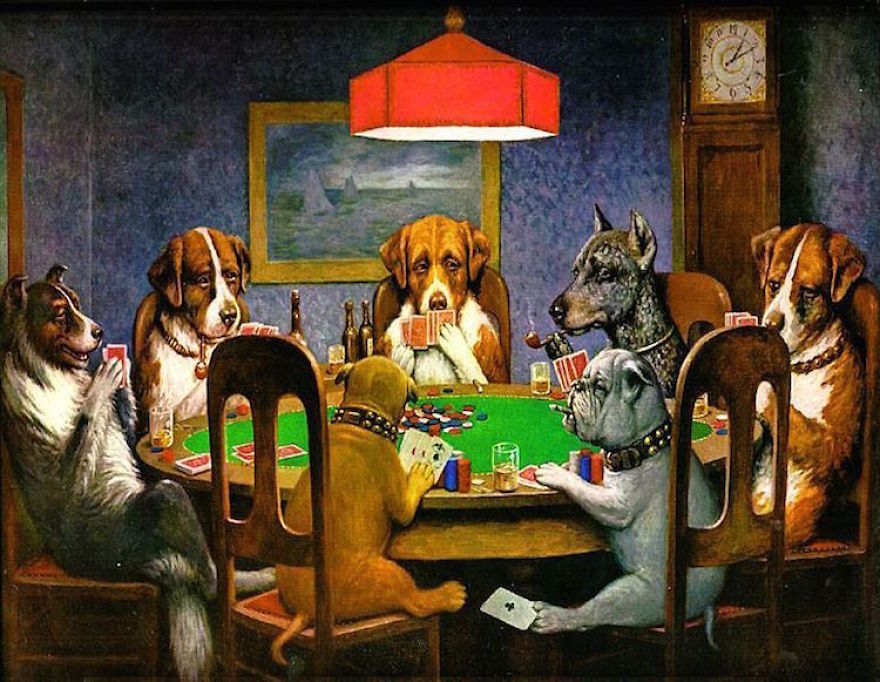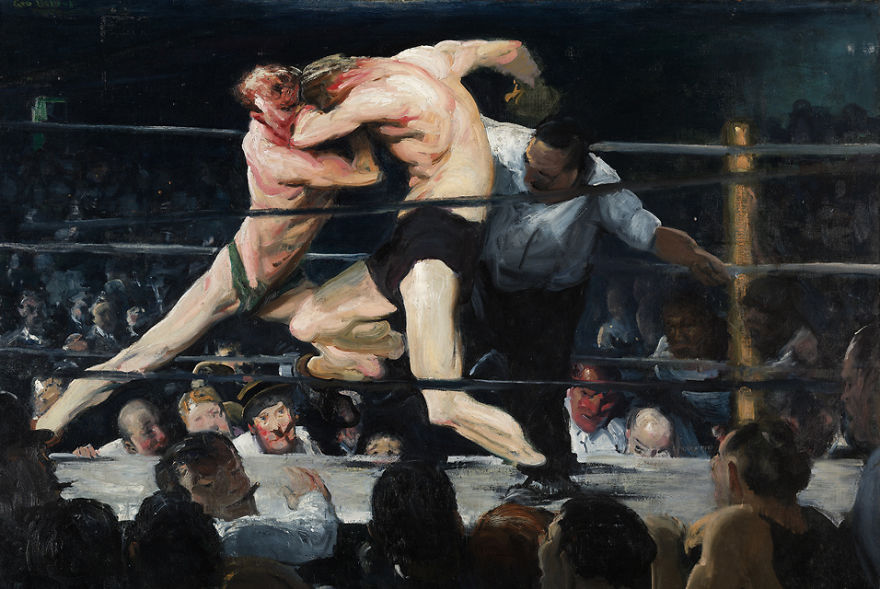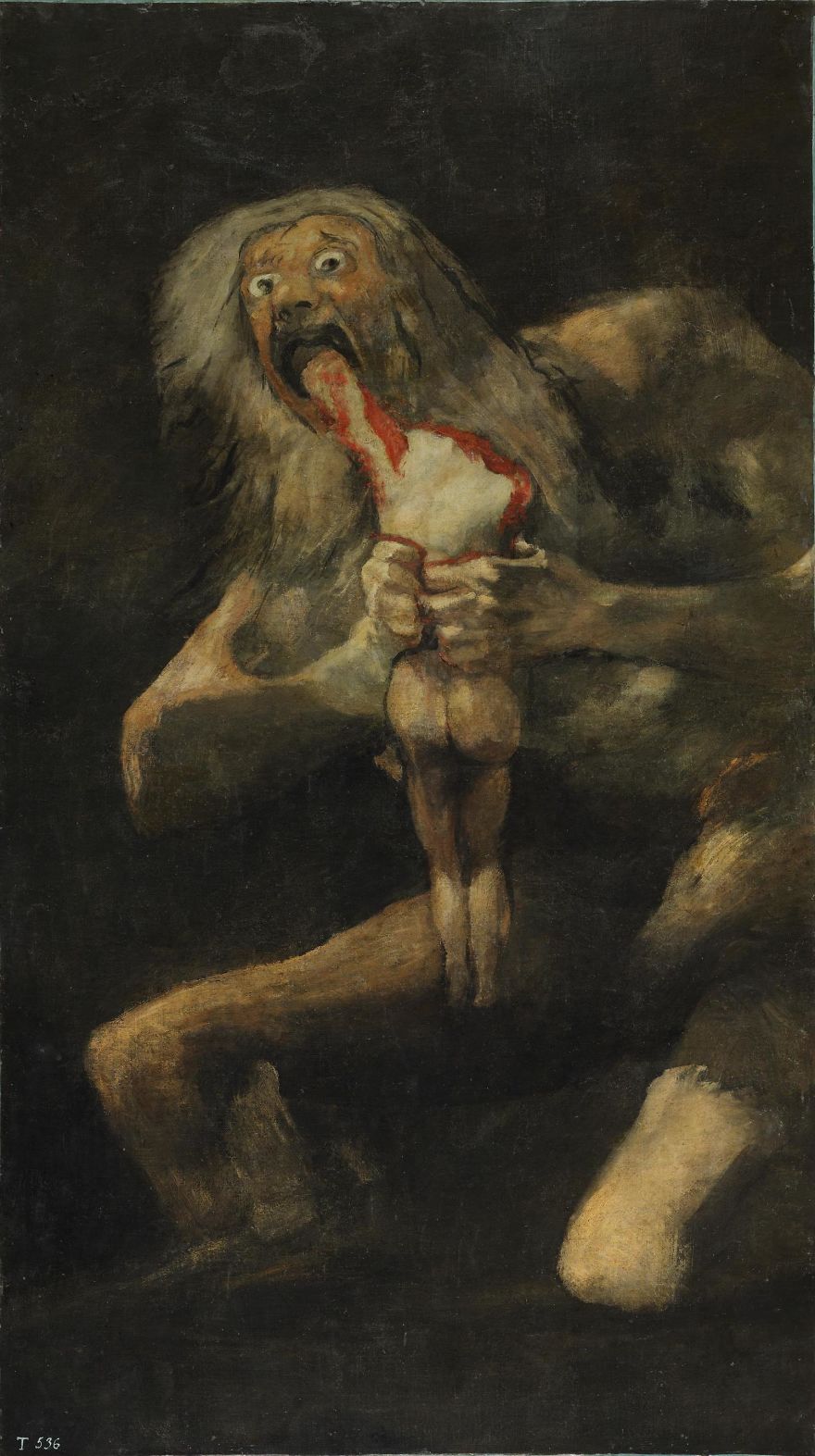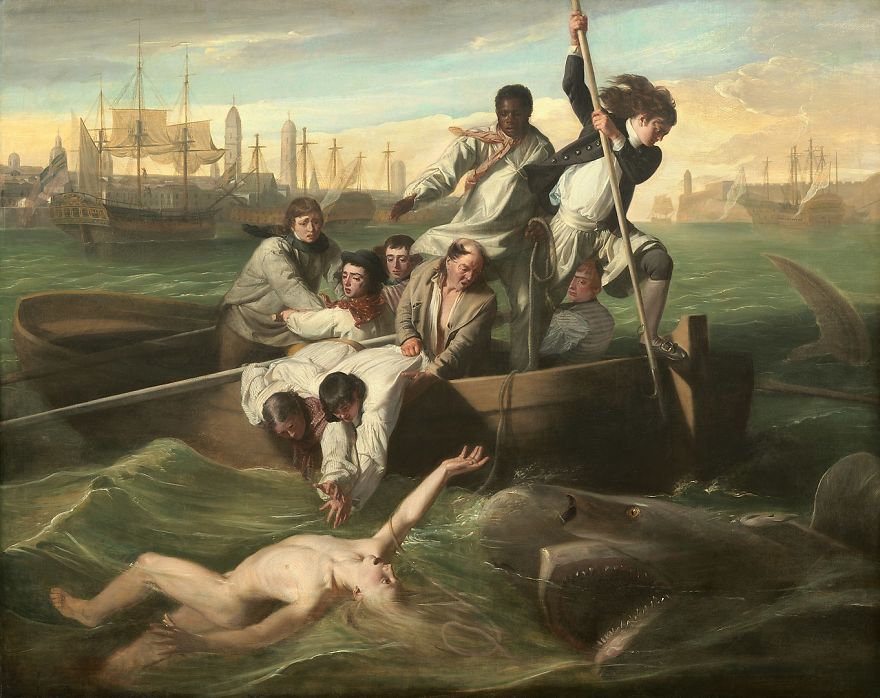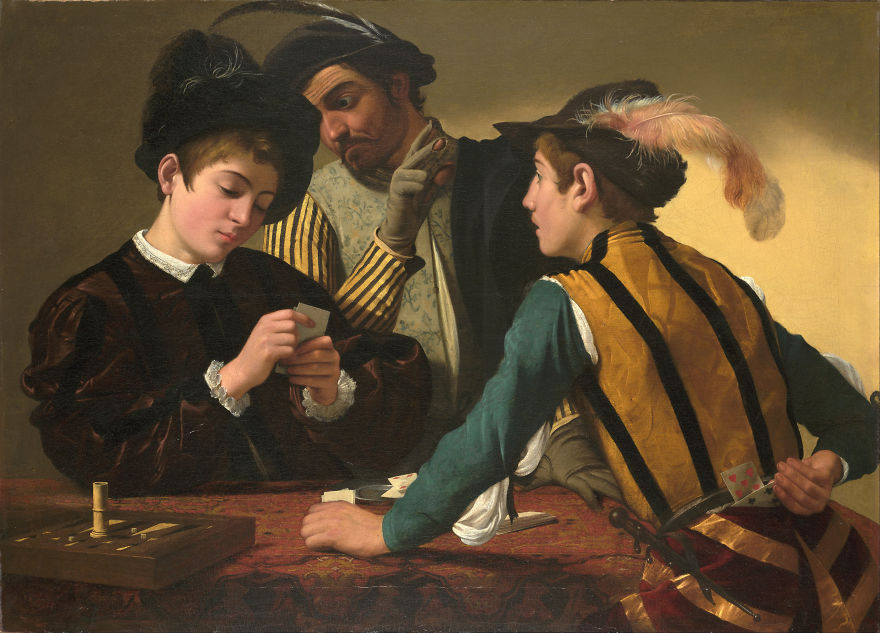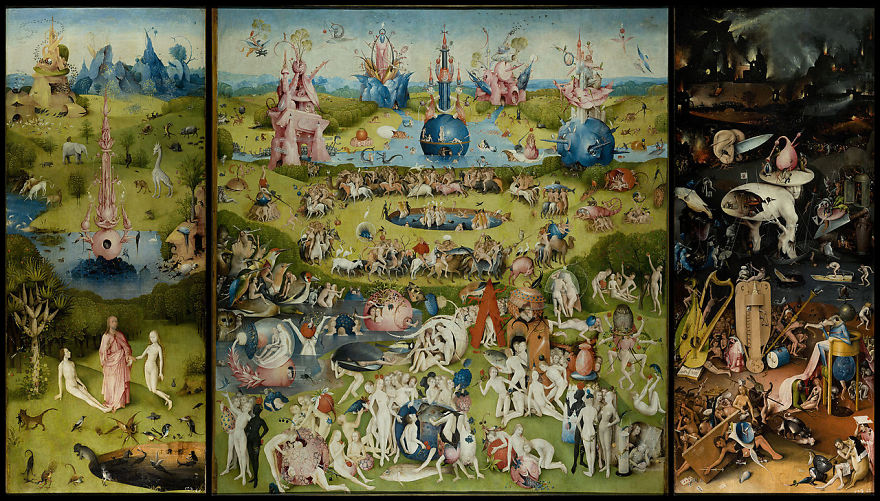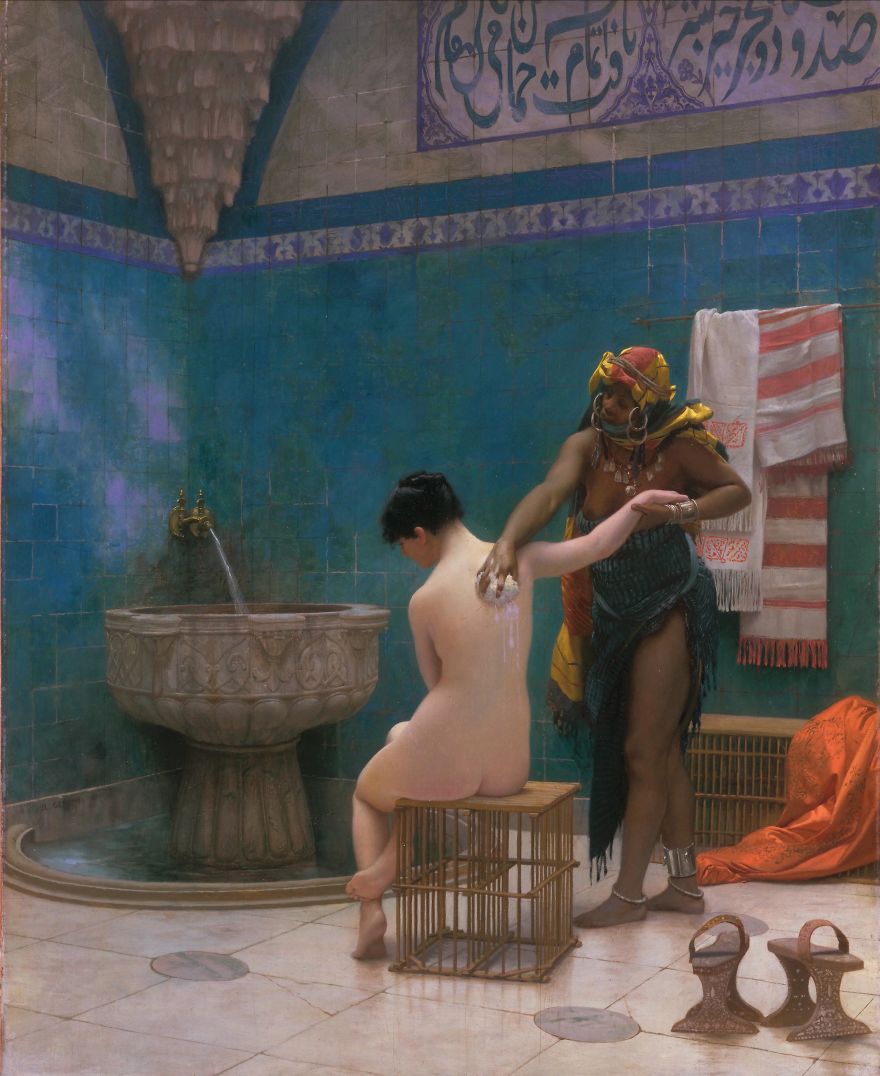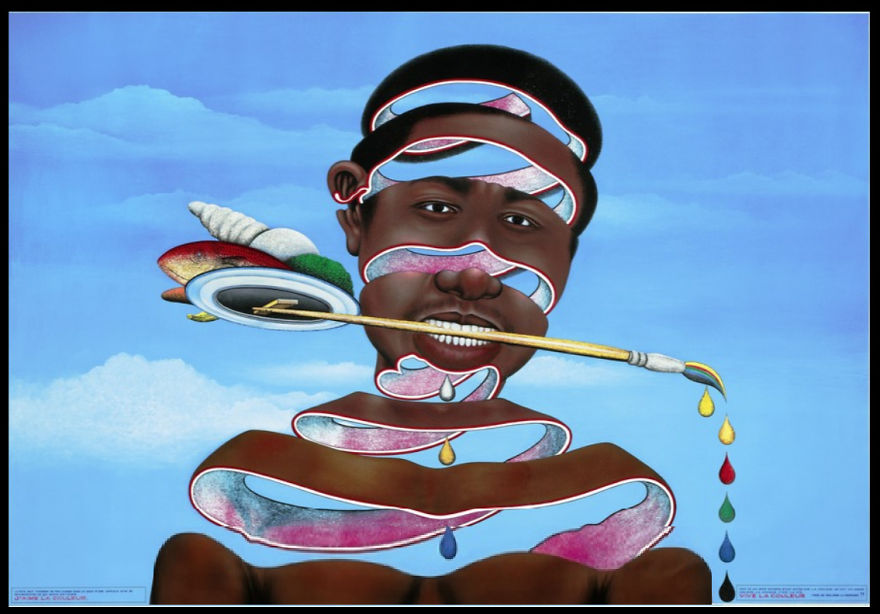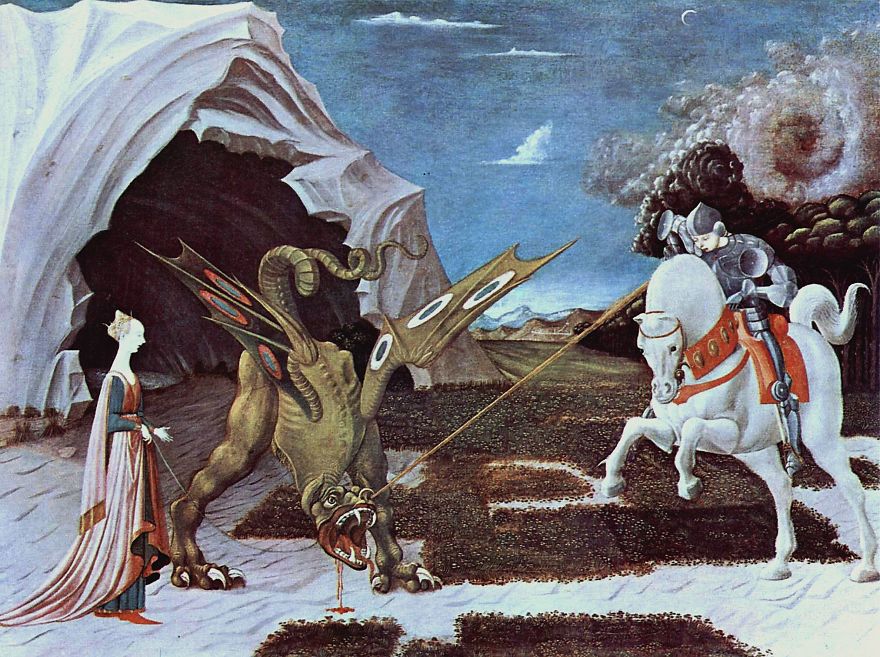While I'm no expert in art history, I find the backstories to famous artworks to be really interesting. So, I wanted to share more interesting stories with you all.
If you are interested, you can find my previous art stories here and here.
This post may include affiliate links.
Starry Night, Vincent Van Gogh, 1889
In the aftermath of a mental breakdown that resulted in the self-mutilation of his left ear, Van Gogh voluntarily admitted himself to the Saint-Paul-de-Mausole lunatic asylum in 1889. During this period, he produced some of the best-known works of his career, including “Irises” and the blue self-portrait. "The Starry Night" shows the view from the east-facing window of his room at the asylum just before sunrise, with the addition of an idyllic village.
It's not the exact same view, but close. I've been in that room and you can see the mountains from there, but not the city or the church. They say it's probably a memory from when he had been outside.
The description says with the addition of a small idyllic village. Addition of gives me the impression it wasn't there in reality.
Load More Replies...I think the backstory should be a bit more elaborate. The swirls and bright yellows (in this painting and other paintings of that time in his life) ar thought to be the result of the anti-depression medicine he was taking.
Swirls of hope that it will be a better day than a night of confusion doubt that leaves you wondering - AM I WORTH IT- why am I here!
I wonder if seeing that kind of beauty while in a very bleak place helped to recover any?
The mind is a wondrous thing, we’ll ever know what he really saw.
Load More Replies...Now something for you to think about - is that bush... a bush or hair of a suicidal woman?
I've heard it conjectured that he suffered from bad migraines (seriously, is there another kind?), which may have contributed to this picture
The Great Wave Off Kanagawa, Katsushika Hokusai, 1829 – 1833
The composition comprises three main elements: the sea whipped up by a storm, three boats, and a mountain. The mountain with a snow-capped peak is Mount Fuji, which in Japan is considered sacred and a symbol of national identity, as well as a symbol of beauty. Using the boats, with their thirty passengers, as a reference, we can see the wave must be close to 12 meters tall. The wave, which curls around like a claw to frame Mount Fuji, shows the artist’s awe and fear of the unpredictable sea.
I thought the background info on this painting would be that Hokusai painted it later in life (he's thought to have been in his seventies at the time), more or less forced back into work to pay off his grandson's debts. While that's a sad fact, it's also inspiring to me that sometimes you can create your best work even when older.
It's claimed he said this on his deathbed "If only Heaven will give me just another ten years ... Just another five more years, then I could become a real painter."
Load More Replies...A great quote from Hokusai (who became 88): “From around the age of six, I had the habit of sketching from life. I became an artist, and from fifty on began producing works that won some reputation, but nothing I did before the age of seventy was worthy of attention. At seventy-three, I began to grasp the structures of birds and beasts, insects and fish, and of the way plants grow. If I go on trying, I will surely understand them still better by the time I am eighty-six, so that by ninety I will have penetrated to their essential nature. At one hundred, I may well have a positively divine understanding of them, while at one hundred and thirty, forty, or more I will have reached the stage where every dot and every stroke I paint will be alive. May Heaven, that grants long life, give me the chance to prove that this is no lie.”
That's not a background story but a quick analysis of the painting ... And in that case, you could also point out that the froth is composed of smaller version of the wave, like a fractal.
Isabel got the closest to what I thought I'd find as a backstory to this. In additiona to what she said, this painting is one of the paintings in Hokusai's '100 views of Mt Fuji' where Fuji is depicted at the background of every-day activities of the people of that time. In this case, it shows fishermen who sometimes would encounter rough sea and would risk their lives to make a living. The size of the mountain and the wave is there to show how big the waves were.
Yes, but the Chinese painting are from the 9th century, almost a millennium earlier! The Japanese had a thousand years to perfect the technic, but the essence is copied. It's like a like a street artist painting in the style of impressionistic masters such as Monet and Renoir, but they may even look nicer, but they are cheap knockoffs.
The Scream, Edvard Munch, 1893
Munch was out for a walk at sunset when the setting sunlight turned the clouds a blood red. He sensed as he put it, an “infinite scream passing through nature.” It has been suggested a volcanic eruption could have attributed to the unnaturally orange sky. Another explanation could have been the result of Munch’s emotional state, as his sister had very recently been committed to a lunatic asylum. Munch created four versions in paint and pastels, as well as a lithograph stone from which several prints survive. Both of the painted versions have been stolen and recovered. One of the pastel versions commanded the fourth highest nominal price paid for a painting at a public auction.
I had the privilege of seeing this painting in person. I can't believe it was painted in cardboard. All of the brown is actually the background showing through.
Many now think the extraordinary sunset was caused by the volcanic eruption of Krakatoa
This is just my opinion, but this makes me think of a person in the midst of a mental breakdown.
I accidentally created a new comment instead of replying to you, but yes your interpretation fits well with what the caption described
Load More Replies...I did this picture the subject is not screaming, they are responding to a screen
That's an odd comment, commanded the fourth highest nominal price paid. So the highest of the lowest prices. Okay. So someone got a bargain
The volcanic eruption in question would have been the Krakatao eruption of 1883. Extremely colourful sunsets is a typical feature of paintings from the subsequent 15 years or so.
I'm an artist, and definitely have... issues. We see the world through a different filter. The best example/explanation of this (that has ever shown up in my life anyway) happened while I was working as a waitress in my early 20s. I was filling a glass with root beer while another server was filling a glass with Coke. I noticed that, compared to the Cola, the root beer flowed in this very soft way. It even sounded different as it left the fountain. I said all of this out loud to the server next to me. He sort of chuckled, and asked, "Are you an artist?" I was a little surprised, and said, "I am. How did you know that?" "You guys just see the world a different way", he replied. This was 22 years ago? Something I never forgot. I've depression, anxiety, substance abuse problems --all sorts of mental health issues all of my life. But my expressions are really quite beautiful. Blessings and curses. Good art IS a little nuts. Art should compel you, the viewer/listener, to feel/think/move..
Load More Replies...Des Glaneuses, Jean-François Millet, 1857
"Des glaneuses" ("The Gleaners") depicts three peasant women gleaning a field of stray stalks of wheat after the harvest. The painting is famous for featuring the lowest ranks of rural society in a sympathetic way. When Millet unveiled the piece in 1857, it immediately drew negative criticism from the upper classes. France had recently come out of the 1848 Revolution, and the upper class saw the painting as a reminder that French society was built upon the labor of the working masses, one of the tenants of the growing Socialist movement. At the time, the working class outnumbered the upper class, and there were concerns the painting might spur the lower class to revolt. With the Revolution still fresh on the minds of the upper classes, this painting was not perceived well at all.
What about the fact that their bags are practically empty and that they are a land that has been picked dry? We need some more information here
to glean - HISTORICAL: to gather (leftover grain) after a harvest. "the conditions of farm workers in the 1890s made gleaning essential"
Nothing to do with slavery. Farmers are picking up their left over twigs.
Load More Replies...Der Wanderer Über Dem Nebelmeer, Caspar David Friedrich, 1818
"Der Wanderer über dem Nebelmeer" ("Wanderer above the Sea of Fog") is true to Friedrich’s Romantic style. It has been said the painting expresses a metaphor for self-reflection as well as the unknown future. In regards to the subject’s position, Friedrich stated, “The artist should paint not only what he has in front of him but also what he sees inside himself."
I've always loved this painting. Probably because I've always been fascinated with images of people overlooking their way ahead, their yet unknown but exciting future (for I believe our future is always exciting and thrilling); we've got this amazing pleasure of not knowing what is going to happen and a great gift of discovering every new day :)
"A metaphor for life as the ominous journey into the unknown". It took a lot of searching and that's the only quote I could find on Wikipedia
Sort of reminds me of the cover of David Bowie's Earthling album (Bowie was known to make allusions to "high" art in his own work).
Susanna And The Elders, Artemisia Gentileschi, 1610
"Susanna and the Elders" shows an uncomfortable Susanna with the two men lurking above her while she is in the bath. The subject is a story from the Book of Daniel, depicting a scene where two elderly men spy on a young woman named Susanna in a garden bath. The two elders demanded sexual favors from her. When Susanna refused, they tried to ruin her reputation until a young man named Daniel intervened. He suggested the men be questioned separately. Their stories did not coincide with each other, so Susanna’s name was cleared.
This part of Daniel is considered apocryphal by some and is not included in non-Catholic/Orthodox Bibles.
Some part of me imagines the meeting where they decided what becomes canonical and what doesn't. "Two men peeping on a young woman? Preposterous! We can't have such obious fibs together with the stories about talking bushes and snakes! "
Load More Replies...More like Prince Andrew and his buddy - forgot his name
Load More Replies...Actually, the painting has many more layers than the simple Bible story. Artemesia was one of a very few successful women artists of the Renaissance. SHe herself was raped by her tutor, her father's friend. The story became quite a scandal of the day when she took him to court and demanded justice. She was all of 14 years old at the time. Later, as a single mother, she went on to have a successful career as a fine artist on the Continent and in England.
https://www.theguardian.com/education/2019/nov/13/artemisia-gentileschis-painting-lucretia-sold-for-almost-48m
Sorry, unless there is a stand alone Book of Daniel, not the Daniel in the Bible
Load More Replies...The Gross Clinic, Thomas Eakins, 1875
This painting is based on a surgery witnessed by Eakins, in which Dr. Samuel Gross treated a young man for an infection of the femur with conservative surgery rather than amputation (standard for the time). A crowd of doctors surrounds the patient as Dr. Gross lectures, with a clinic clerk over his shoulder taking notes. Sitting to Dr. Gross’s left is a lone woman, the patient’s mother, recoiling in horror. The painting has an important place in the history of medicine, because of its role in the emergence of surgery as a healing profession (as opposed to a means for amputation), and because it shows what the surgical theater looked like in the nineteenth century.
Women dreaded giving birth in hospitals because of the horrendous amount of women who would die having given birth there. Doctors would go straight from dissecting a corpse to delivering a baby. Without washing their hands. "Ignaz Semmelweis (1818 – 1865), was a Hungarian physician called the “saviour of mothers” who discovered, by 1847, that the incidence of puerperal fever, also known as childbed fever could be drastically cut by use of hand washing standards in obstetrical clinics." https://semmelweis.org/about/dr-semmelweis-biography/
Load More Replies...Смешнее всего анестезиолог на заднем плане, который душит пациента пучком ваты или подушкой, чтобы не мешал своими воплями лектору.
I don't know if it was a good thing or a bad thing for them to perform the surgery. On the one hand, the patient didn't lose a limb, however on the other, the surgical conditions were not the most sanitary.
If the surgical conditions weren't so sanitary, I think amputation would be even worse. Not only a limb is lost, but as the open wound remains, remember, in not so sanitary conditions, infections are still prone to happening.
Load More Replies...Barge Haulers On The Volga, Ilya Repin, 1873
This work is a condemnation of profit from inhumane labor. Although they are presented as stoic and almost accepting of their fate, the men look rather defeated. Only the youngest is a brightly colored youth standing upright and fighting against his leather binds. Repin conceived the painting during his travels through Russia, and it depicts the actual characters he encountered. The piece drew international praise for its realistic portrayal of the hardships of working men and launched his career.
Jacques Sandalescu was abducted at 16, forced to work in the coal mines of Russia. His book 'Donbas' tells it.
А почему дым от парохода на заднем плане и флаг на мачте в разные стороны?
Is that an american tourist with a pipe, sunglasses, and a fedora ??
The Raft Of Medusa, Théodore Géricault, 1819
"The Raft of Medusa" ("Le Radeau de la Méduse") depicts the aftermath of the wreck of the French naval frigate Méduse. At least 147 people were set adrift on a hurriedly constructed raft; all but 15 died in the 13 days they awaited rescue. Those that survived endured dehydration and starvation to the point of practicing cannibalism. The event became an international scandal, in part due to the perceived incompetence of the captain of the Méduse.
I've seen this image before and I had no idea it was based on actual events.
Neither have I. And had no idea this real event was of such a horrible nature.
Load More Replies...The creation of this painting was actually fascinating in and of itself. Gericault wanted his painting to be as accurate as possible, so he went to the morgue to study dead bodies, particularly those who had drowned. He interviewed survivors of the incident, and he even had a replica of the raft built in his studio! Not only that, but at the time, large scale paintings were reserved for "history paintings"- paintings of historical, biblical, or mythological scenes. Contemporary scenes like this one were not common, so to have a scene like this painted when the tragedy of the event was still fresh on everybody's mind was quite a shock when it was first exhibited in the 1819 Salon!
One of my art books on drawing uses this painting to illustrate composition based upon the triangle. There are triangles everywhere, triangles inside of triangles, all of which produce a raft of incredible stability against the raging seas. This is a remarkable artistic achievement.
The ship ran aground off the coast of Mauritania on 2 July 1816.
Load More Replies...Ok, but why would 3 of the men be naked? Clothing would help protect them from the harsh sun.
Perhaps some are dead and their clothing is being used by others, and some have contributed their clothing for the purpose of attracting attention (as appears to be happening with the two in the top-right). Or perhaps it's more hot than it is sunny.
Load More Replies...The Potato Eaters, Vincent Van Gogh, 1885
Van Gogh wanted to depict peasants as they really were, and deliberately chose models who were coarse in aesthetics. He wanted to show a wholly different way of life from the upper classes. He later wrote to his sister and claimed "The Potato Eaters" to be his most successful painting.
I actually do prefer this to some of his more famous work; it shows much more emotion than say Starry Night I think, also the colors and harsh lighting contrasts on the angles of their faces contribute to a particularly interesting aesthetic
But Starry Night came later as he slipped into madness and his work became more rhythmic. I love both paintings for different reasons.
Load More Replies...A Friend In Need, Cassius Marcellus Coolidge, 1903
"A Friend in Need" is the most popular painting of the "Dogs Playing Poker" series by Cassius Marcellus Coolidge. The series was originally commissioned by Brown & Bigelow to advertise cigars. All eighteen paintings featuring anthropomorphized dogs, with eleven depicting card games. While Coolidge’s paintings were never considered genuine art by critics, they have since become iconic, with the first of the series, "Poker Game", recently selling at Sotheby’s for $658,000.
I have always loved these, they are among my first memories of art. I would love to have the entire set
All the internet stories and photos of surprising emotions and thoughts from animals have changed my mind about Dogs Playing Poker.
So his parents decided to call him Cassius Marcellus. I wonder how they felt about his career painting anthropodoggies?
Stag Night At Sharkey’s, George Wesley Bellows, 1909
"Stag at Sharkey's" depicts two boxers fighting in the private athletic club situated across from Bellow’s studio. Participants were usually members, but occasionally outsiders, known as “stags,” would get a temporary membership and fight. The piece is part of the Ashcan School movement, known for depicting daily life in early twentieth-century New York, usually in the poorer neighborhoods. Bellows used quick strokes to create a blurred image of two fighters in motion. He chose a low point of view to put the viewer among the crowd watching the fight.
To me, the proportions are off. That extended leg is way too long. It makes me uncomfortable. Perhaps this is on purpose
Saturn Devouring His Son, Francisco Goya, 1823
"Saturn Devouring His Son" depicts the Greek myth of the Titan Cronus (Romanized to Saturn), who, fearing that he would be overthrown by one of his children, ate each one upon their birth. The work is one of the 14 Black Paintings that Goya painted directly onto the walls of his house.
This painting has always strongly fascinated and disturbed me at the same time. Also, it always looked like Saturn was eating his son like a gingerbread cookie. 🤣
I remember this super clearly from childhood (fairy tales, greek mythology, same thing, right?) - And also being ... confused... because in that story, apparently the story is that he swallowed 'em all whole... which is why he was able to vomit up the entire pantheon later on...
Load More Replies...Saturn, the planet, is a gaz giant. When it formed, it's gravity pulled newly forming planets to fall upon it. It's what the mythology means. A myth is a truth disguised in a children's story. Titan is one of Saturn's moon, filled with methane. Zeus is Jupiter, the King of gods. Planet Jupiter has a nice harmonic electromagnetic field, it "sounds" nice if you listen to the NASA recording on YouTube, from the VOYAGER 1 probe we sent out our solar system.
Composition Viii, Wassily Kandinsky, 1923
Kandinsky had been fascinated with color from an early age, considering it to have transcendental properties. The artist wished to explore an interrelation between sound and color in the same way a musician composes a song. The use of circles, grids, rectangles, semicircles, triangles and other mathematical forms in the artwork is consistent with the painter's belief in the mystical properties of geometric shapes while the colors were chosen for their emotional impact.
That's exactly the point. The painting is like a flower (you don't ask "what this flower represents"), it doesn't represent something, except for itself. It doesn't depict another thing, it's meaning is self-contained. It's not about some myth, somebody, or some historical event, or even about another thing. Well, that's what I think...
Load More Replies...The main starting point of his artwork was his synaesthesia, where the senses overlap. He could see sounds and how things felt and they produced different images to him. He used these images as the basis of his work and compposed abstract pieces using them.
I see a powerful relationship between music and colors and shapes. Does this say more about me than the artist?
Paul-Émile Borduas is a famous painter from Québec, he wrote the "Manifeste du refus global" in the 1950s and that started our "révolution tranquille" (peaceful revolution). If you look at his paintings, it looks abstract, but is really figurative. The color red comes towards you. The color black stays put. So he puts a red figure behind a black shape, and it makes it "stand in the air", if you look at it with semi-closed eyes. Real Beautiful. Kandinsky wrote a book about analogies between colors and sound. I didn't read it, but a friend of mine did and told me about it. It's real. Red is below, violet is above. Some sounds are "red" (musical note: C or Do (in french) and all the colors of the rainbow are there in the sound up to violet (B or Si (in french). 7 notes = 7 colors, they match up. Why? They are both wavelengths. That's it!
I love the balance he created here, and I do get sound from it; almost like abstract notation
I adore this piece and I hate math but math is why my human calculator hubby loves it.
Watson And The Shark, John Singleton Copley, 1778
"Watson and the Shark" depicts the rescue of a boy from a shark attack in Havana, Cuba in 1749. Brook Watson, then a 14-year-old cabin boy on the Royal Consort, lost his leg in the attack and was not rescued until the third attempt, which is the subject of the painting.
“Watson, I have some recollection that you go armed upon these excursions of ours.”
Cardsharps, Caravaggio, 1594
The players of a game of primero (pre-poker), consist of a dupe and two cardsharps engaged in a con. Caravaggio has treated this subject not as a caricature of vice but in a novelistic way, in which the interaction of gesture and glance evokes the drama of deception and lost innocence in the most human of terms.
Faces are like those of Manet! The rendering is flawless! HE knew how to paint real stuff.
I agree completely! I know next to nothing of art, but after your comment, I will be looking up Manet's work. I was also taken with the colors of the feather in the lad's hat, and the attention to detail (tablecloth, man's vest, woman's collar, etc.).
Load More Replies...The Garden Of Earthly Delights, Hieronymus Bosch, 1490-1510
Little is known of Bosch's life or intentions, but the intricacy of its symbolism, particularly that of the central panel, has led to a wide range of scholarly interpretations. Twentieth-century art historians are divided as to whether the triptych's central panel is a moral warning or a panorama of paradise lost. Peter S. Beagle describes it as an erotic derangement that turns us all into voyeurs.
Like Hokusai's works, except Bosch's are centuries older, wich is even more amazing, they look so modern; you could absolutely believe that they belong to artists of the 21st century, and that speaks to the genius of these masters. The more you look at these the more awed and fascinated you become...
'Erotic derangement that turns us all into voyeurs'...is this also quite a good description of modern day society, where people are glued to phones, gazing at other people's lives? (She says, glued to her phone...😆)
I-ve always been amazed at how he effectively invented surrealism centuries before Dalí made it famous.
The Bath, Jean-Léon Gérôme, 1885
Gérôme’s European prejudices are undeniable in the dynamic between the two figures in "The Bath". The paler female nude, which Gérôme clearly based upon European women, is attended to by a darker-skinned slave. Setting up a hierarchy of skin tone. The paler woman is to be objectified, while the woman of color takes on a submissive role. Since there was no way for Gérôme to have been allowed in these very private female spaces, it can be assumed this piece reflects the artist’s own prejudices.
This is not an intriguing story about the painting, just your opinion of it. First, Gérôme was part of the Orientalist movement, which depicts mostly imagined scenes of a fantasized North Africa and Middle East. Second, no it is not just the artist's own prejudices: many slaves in the Ottoman empire (and other countries of this part of the world) were black, and people from Turkey, Arabia peninsula, Maghreb are lighter-skinned. Thinking she is a European woman is your own prejudice. Third, remove the paintings with naked women and you won't have much left in museums. Whether it is art or objectification is a heated discussion. Your other comments were much better built than this one.
I agree. For all we know this was just a picture of what the artist assumed life was like. Could have been trying to show a scene of daily life. Not sure about objectification, either, as you can't actually see any nude details. The black woman is beautiful. One could just as easily interpret this as speaking out against slavery.
Load More Replies...From the wall writing in the painting, I'm assuming its location was supposed to be Middle Eastern?
Possibly northern African. I'm thinking Egypt or Morrocco.
Load More Replies...I was looking at them too. I think that they are, can you imagine walking on those?
Load More Replies...It was not unusual for Muslims to buy white women as slaves, and believe that their brown skinned counterparts were more substantial in the work arena. These lighter skinned women, and particularly the red headed ones, were very often used as sex slaves until the Moguhls tired of them. This is still a common practice, and not unusual for them to hire Filipino women, take away their passports, make them sleep in the nude, and beat them. There have been many instances of these women running for freedom in the Galleria in Houston, when their captors are there for medical treatments. The Muslims rent entire floors of hotels where they bring in live animals to butcher so they have Halal meats, letting the blood run down the floors into the ceilings below. I know, because I worked for a company that had to repaint the entire hotel.
What utter rubbish The painter would not have been thinking about that at all! And what makes you think he wouldn`t have seen this himself?
Okay but the 'darker' slave appears to be STRONGER and more able the white girls is needy and submissive!
So maybe the white girl is a new purchase/captive and is being carefully prepared for her first meeting with her new owner. And yes, those are shoes. Most likely overshoes to be worn to raise the wearer above the running mud and sewage in the streets.
Load More Replies...J'aime La Couleur, Chèri Samba, 2003
In "J'aime la couleur", the artist's head is portrayed as a winding spiral against a bright blue sky. He holds a dripping paintbrush between his teeth. The work is an expression of how Samba equates color to life. “Everything is color,” he says, and the spiraling portrait conveys how we must unravel to see the color in our lives.
It's rather inspired by M.C. Escher's "Rind" from 1954 or "Bond of Union" from 1955. escher-spi...7d76de.jpg 
St. George And The Dragon, Paolo Uccello, 1470
"Saint George and the Dragon" shows off the gothic tendencies in Paolo Uccello's art. Within the painting is a scene from the famous story of the same name, with George spearing the beast on the right and a princess using a lead to take it to town. Devine intervention is indicated with the storm gathering on the right of Saint George. The painting was the inspiration for the U. A. Fanthorpe poem, “Not My Best Side,” and for Sir John Tenniel's illustration of the Jabberwock in “Through the Looking-Glass,” and “What Alice Found There.”
Meanwhile some random woman with the dragon on a leash is gesturing, "WTF, dude?"
That's how I saw it, too. This princess was taking her pet dragon for a walk into town, and this guy comes up and stabs it because God spoke to him?
Load More Replies...Вот, уже и собачку нельзя выгулять! А обосравшийся от страха Джордж (не Горгий) закованный в латы так и норовит убить домашнее животное! Жуткие времена!
Shouldn't the dragon have arms? Also, it has round marks on the wing like a friggin' RAF fighter.
I absolutely love your art posts. I lays wind up spending a few hours doing more research on the artwork you feature. Thank you!
I really liked this article — it was informative and interesting to read! More please!
Alexander Calder was trying to create 3D kinetic versions of Piet Mondrian's "Studies in Color" series when he invented the mobile.
I love it! Some I didn't know, like Bellows. That painting is what's happening here and now too. Labor class vs Economy's elite.
I absolutely love your art posts. I lays wind up spending a few hours doing more research on the artwork you feature. Thank you!
I really liked this article — it was informative and interesting to read! More please!
Alexander Calder was trying to create 3D kinetic versions of Piet Mondrian's "Studies in Color" series when he invented the mobile.
I love it! Some I didn't know, like Bellows. That painting is what's happening here and now too. Labor class vs Economy's elite.

 Dark Mode
Dark Mode 

 No fees, cancel anytime
No fees, cancel anytime 







